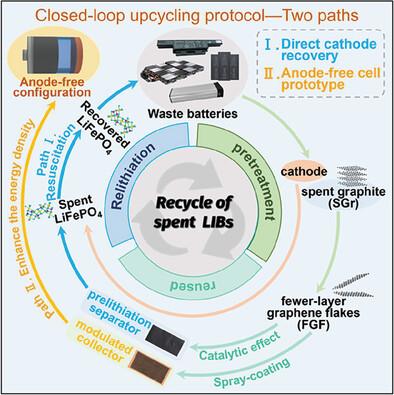将废石墨阳极升级再利用到预硫化催化剂中:实现无阳极电池原型的分离策略
IF 27.4
1区 材料科学
Q1 CHEMISTRY, MULTIDISCIPLINARY
引用次数: 0
摘要
锂离子电池(LIB)的大量生产需要可持续、循环和去碳化的回收策略。虽然人们致力于利用复杂的化学工艺从正极中提取有价值的金属,但直接、高效的正极再生仍是一项技术挑战。更紧迫的是,电池供应链还需要对报废阳极进行增值开发。在此,我们提出了一种 "闭环 "方法,通过对层间距和缺陷浓度的微妙调整,将废石墨循环利用为预锂化催化剂,即少层石墨烯薄片(FGF)。由于催化 FGF 可减轻煅烧过的 Li5FeO4 纳米晶体的脱锂能障,因此,将其浇铸在聚烯烃基底上的复合层可实现定制的预锂化能力(98% 的 Li+ 利用率),用于回收已退役的 LiFePO4。此外,疏水性聚合物改性保证了 Li5FeO4 制剂的耐湿性,符合商业电池制造标准。隔膜策略很好地调节了无阳极袋式电池(LiFePO4||Cu)的界面化学性质,其原型兼顾了稳健的循环性、高达 386.6 Wh kg-1 的能量密度以及 1159.8 W kg-1 的极限功率输出。这项研究不仅实现了石墨升级再循环的可持续供应链,还为无阳极电池原型设计建立了通用、可行的协议。本文章由计算机程序翻译,如有差异,请以英文原文为准。

Upcycling the Spent Graphite Anode Into the Prelithiation Catalyst: A Separator Strategy Toward Anode-Free Cell Prototyping
The substantial manufacturing of lithium-ion batteries (LIBs) requires sustainable, circular, and decarbonized recycling strategies. While efforts are concentrated on extracting valuable metals from cathodes using intricate chemical process, the direct, efficient cathode regeneration remains a technological challenge. More urgently, the battery supply chain also requires the value-added exploitation of retired anodes. Here, a “closed-loop” approach is proposed to upcycle spent graphite into the prelithiation catalyst, namely the fewer-layer graphene flakes (FGF), upon the exquisite tuning of interlayer spacing and defect concentration. Since the catalytic FGF mitigates the delithiation energy barrier from calcinated Li5FeO4 nanocrystalline, the composite layer of which cast on the polyolefin substrate thus enables a customized prelithiation capability (98% Li+ utilization) for the retired LiFePO4 recovery. Furthermore, the hydrophobic polymeric modification guarantees the moisture tolerance of Li5FeO4 agents, aligning with commercial battery manufacturing standards. The separator strategy well regulates the interfacial chemistry in the anode-free pouch cell (LiFePO4||Cu), the prototype of which balances the robust cyclability, energy density up to 386.6 Wh kg−1 as well as the extreme power output of 1159.8 W kg−1. This study not only fulfills the sustainable supply chain with graphite upcycling, but also establishes a generic, viable protocol for the anode-free cell prototyping.
求助全文
通过发布文献求助,成功后即可免费获取论文全文。
去求助
来源期刊

Advanced Materials
工程技术-材料科学:综合
CiteScore
43.00
自引率
4.10%
发文量
2182
审稿时长
2 months
期刊介绍:
Advanced Materials, one of the world's most prestigious journals and the foundation of the Advanced portfolio, is the home of choice for best-in-class materials science for more than 30 years. Following this fast-growing and interdisciplinary field, we are considering and publishing the most important discoveries on any and all materials from materials scientists, chemists, physicists, engineers as well as health and life scientists and bringing you the latest results and trends in modern materials-related research every week.
 求助内容:
求助内容: 应助结果提醒方式:
应助结果提醒方式:


